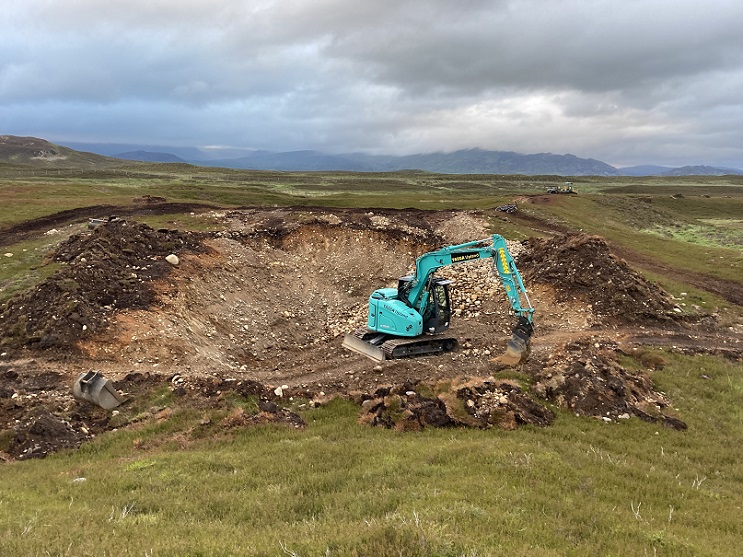
Following my most recent post on the Ralia hill road (see here), I was sent further photos which support my argument that the road upgrade work should have required full planning permission. The Construction Method Statement accompanying the Prior Notification, which was produced by Taiga Upland in conjunction with Kilrie Trees and approved by Highland Council, stated:
“4.1 Where additional material is required to build up the road surface, this will be imported from a local quarry site. No material will be won from localised small borrow pits.”
I can find no local quarry site from maps for the location depicted in the photo. It also looks new, with freshly stripped turves and exposed piles of peaty soil but, whatever the truth about this particular borrow pit/quarry, it is not the only one!
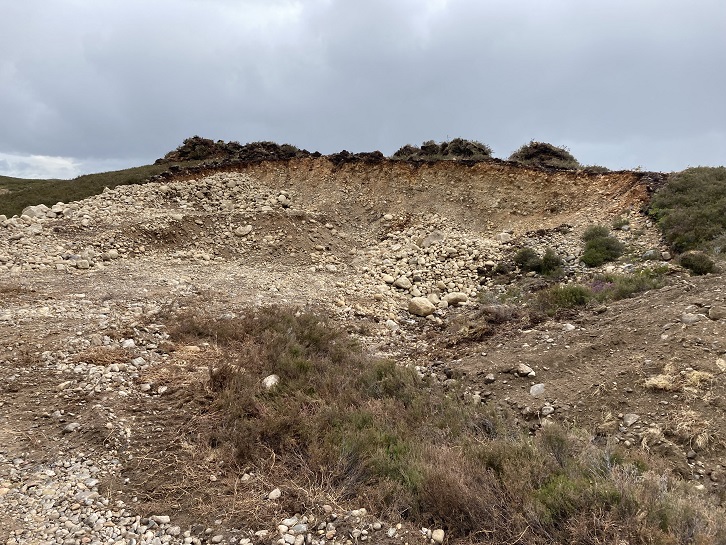
The claim in the Construction Method Statement that material would be imported from “a local quarry” was clearly wrong. The size of the quarries also provides proof, if more is needed, that the recent work on the road constitutes far more than repairs and should therefore, as clearly stated to the applicants by Highland Council, have required planning permission.
A further photo from Dave illustrates how the material from these quarries has been used to widen the existing track, again contrary to what Highland Council approved.

I sent some of these photos to the Cairngorms National Park Authority and Highland Council and am pleased to report that CNPA staff have been out to visit and that the two public authorities appear to be working closely on this. We will see what happens but I am very grateful to all the readers who have sent photos, without them it might have taken the CNPA much longer to act.
The relationships between Abrdn, Akre/Kilrie trees and Ralia
Renwick Drysdale from Akre Ltd, also known as Kilrie Trees – whose name is on the Construction Method Statement – has commented on a previous post on Abrdn and Ralia on this blog (see here). He is also on record (see here) as claiming to have:
“helped to advise the high-profile Abrdn acquisition of 1500 hectares of the Cairngorm National Park………….where they will grow the majority of trees in the future.”
What he doesn’t appear to have explained, in this and other publicity about the purchase, is his family connection to the Ralia estate. I was first tipped off about this by a local resident.
Andy Wightman’s Who Owns Scotland website records the ownership of the Ralia and North Drumochter Estate which sold “Far Ralia” to Abrdn:
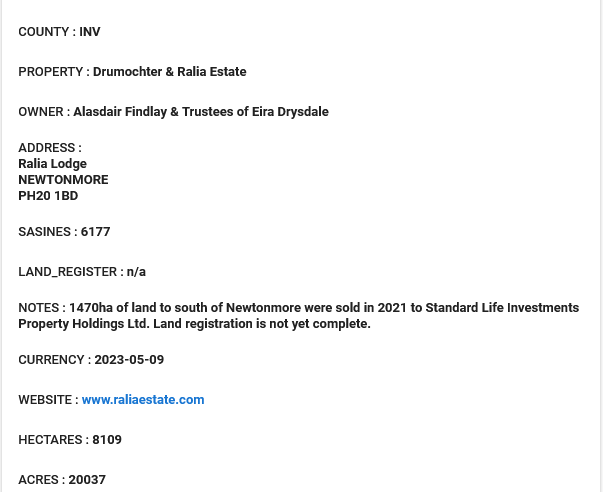
Note the names, “Findlay” – who is often referred to as the laird (see here) – and “Drysdale”.
There is little information publicly available about the Eira Drysdale Trust. Data from Opencorp (see here) shows an “Eira Drysdale Ralia Trust” which is registered at Kilrie Farm, the same address as Kilrie Trees/Akre Ltd but unless the difference in name is a mistake this appears to be another trust with a different function. As part of its compulsory purchases for the dualling on the A9 in September 2021, however, Transport Scotland published information (see here) which showed (under 2) that there were three trustees of the Eira Drysdale Trust:
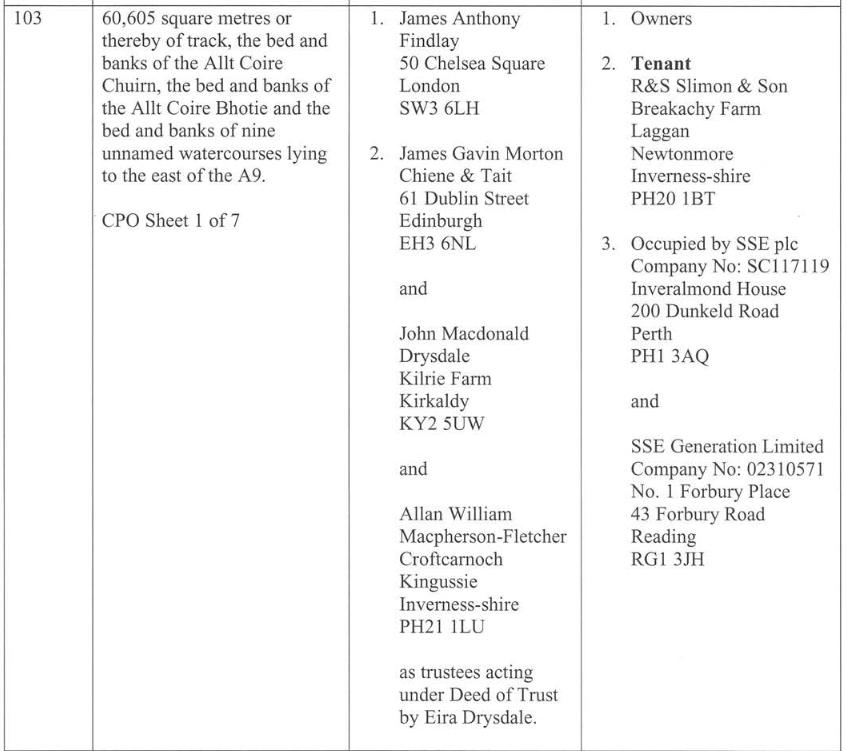
The second named Trustee, John MacDonald Drysdale, appears to be the father of Renwick Drysdale. He is also listed on Companies House as being a Director of Akre Trees, with the address of both being given as Kilrie Farm:
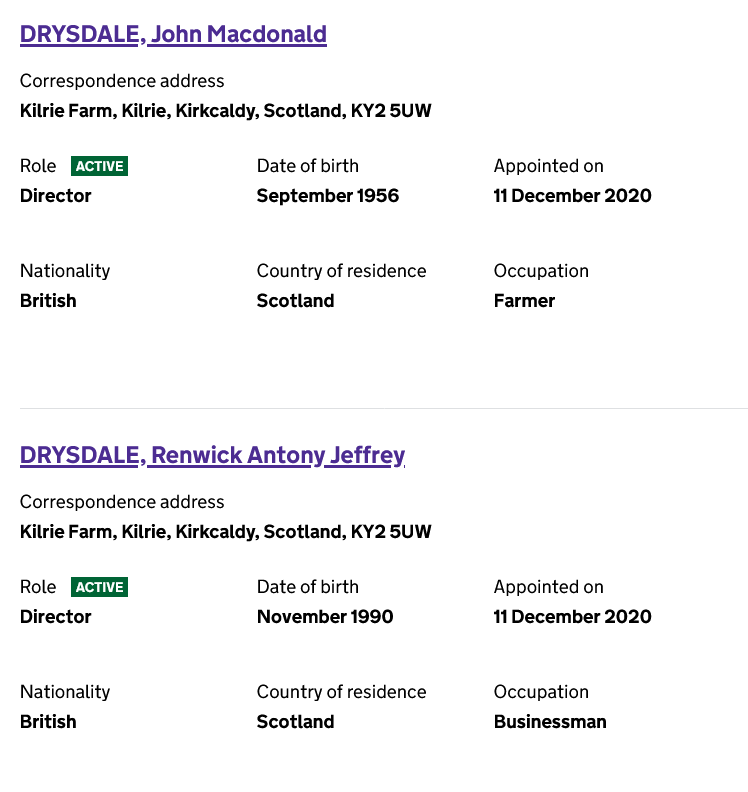
Establishing the exact nature of the connections between the families is difficult but other sources show there was an Eira Findlay who later married a Drysdale. What is clear isthat there are strong and ongoing family connections between the Findlays and Drysdales, the Ralia Estate and Kilrie Farm.
Any advice that Renwick Drysdale gave Abrdn about the purchase of Far Ralia, therefore, was hardly independent, even if his father stepped down as a Trustee of the Eira Drysdale Trust between 1st July 2021, the date of the Transport Scotland compulsory order, and September 2021 when SLIPIT (now Abrdn) bought the land. This raises questions about whether Abrdn were aware of the relationships and potential conflicts of interest and, if so, how they managed them?
Abrdn out of their depth?
Scottish Forestry has released communications with Abrdn prior to their purchase of Far Ralia as a result of a Freedom of Information request.
The emails reveal that Abrdn had little idea about land-management, was in receipt of conflicting advice and did not know who to believe. For example:
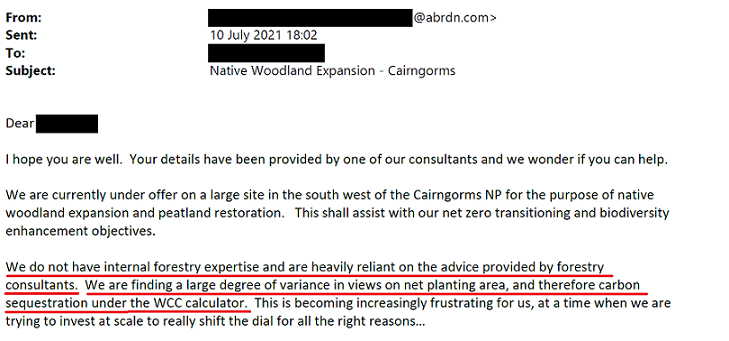
A day later another email elucidated:
“We are advised that up to 950 hectares can be planted. However we have received a second opinion from a larger firm to provide a market appraisal and view on the planting plan and they are suggesting that far more conservatism should be applied to areas above 400 and 450m
i.e. “marginal areas”. Their initial view is a net planting area as low as 703 hectares”
It then went on to say:
“The 26% differential in opinion thus far is hugely concerning when we are being asked to pay a substantial sum for the land in question.”
A further email, dated 14th July, suggests Abrdn had no appreciation at that time of the importance of peat for carbon sequestration and that they were solely interested in planting trees:
“Does policy support planting on peat depth of up to 30cm? Hinge mounding and inverted mounding will be the ground prep methods. Out of interest what happens where peat depth is 40cm?”
Given Abrdn’s understanding, it would appear that the more trees that could be planted at Far Ralia, the more that they might be prepared to pay for the land. That takes us back to the family connection between the Findlays and Drysdales, Ralia Estate and Kilrie Trees and whether it was Renwick Drysdale/Kilrie trees who was advising Abrdn 950 hectares could be planted? In the event the Woodland Grant Scheme application, which is still under consideration by Scottish Forestry, is for an area of 842.54 hectares.
The emails from Scottish Forestry reveal that Abrdn was interested in “potential grant funding to offset some of the cost”. By the time the WGS application was submitted, however, Abrdn was aware that they could also make carbon offsetting claims under the Peatland Carbon Code, which might compensate for any reduction in the area planted with trees, and had no doubt been informed that the Cairngorms National Park Authority had plenty of money to pay for peatland restoration which would help offset other costs.
Whatever the exact explanation, SLIPIT/Abrdn paid significantly more per acre for Far Ralia than other land sales at the time (see here), advised on his own admission by Renwick Drysdale who had a family interest in the land which was sold, his father being or having been a trustee of the Eira Drysdale Trust.
It may be the case, however, that from Abrdn’s perspective, it really didn’t matter whether they received consistent advice so long as those they engaged managed to hoover up government grants.
What was the agreement between Abrdn and Ralia?
Almost two years after SLIPIT/Abrdn’s purchase of Far Ralia, the details have still not been published on the Registers of Scotland or made public so the public do not know what conditions were agreed as part of the sale..
It is almost certain, however, that they will include a servitude of access across part of the road network on the Ralia Estate to enable vehicles to get from the A9 to the land bought by Abrdn, Far Ralia as it is now known. It would also be fairly standard that as part of such a servitude, any upgrade to these roads required to enable work at Far Ralia would be the responsibility of Abrdn. Hence why the two Prior Notifications to upgrade the Old Military Road (see here) and build a new bridge (see here) were submitted in the name of Abrdn, not the Ralia Estate.
What that doesn’t explain, however, is why the paperwork for the two Prior Notifications for the track at Ralia claimed only minor repairs were required to the hill track above on Far Ralia when that section of road is in far poorer condition. While it is possible that Abrdn agreed to upgrade the main road on Ralia as part of the sale deal, it appears that the Prior Notification may also have been submitted as a trojan horse submitted in the knowledge that the CNPA had a policy presumption against new hill roads (and significant upgrades) because of the impact on the landscape.
There is also, however, the question of whether Ralia retained any sporting rights in respect of Far Ralia? I observed in an earlier post that Kilrie Trees application on behalf of Abrdn for a new bothy (see here) looked remarkably like a shooting hut. Moreover, the Woodland Grant Scheme is now used by many sporting estates is provide new habitat for pheasant shooting and there appears to be nothing in the conditions of grant to prevent this. From a sporting perspective that would make sense at Far Ralia where deer numbers appear to have plummeted due to Wildland Ltd’s culls in Glen Tromie and where there is limited scope for grouse shooting.
Until the facts are known, this is speculative, but it appears possible the owners of Ralia may pulled off a remarkable deal in which they managed to raise a significant amount of capital, retained their sporting rights, extended the potential to develop pheasant shooting and created a business opportunity for Akre and Renwick Drysdale (whose plans for the land I will consider in a further post) all of which has been marketed by Abrdn as a pioneering carbon offsetting initiative (see here for recent video about Ralia).
Contrast what is claimed in that video with the recent investigation by the Ferret (see here), which was also published by the Sunday Herald yesterday, which revealed Abrdn huge investments and profit making out of fossil fuel production. Abrdn was quoted as claiming it is:
“committed to driving the change” required to meet climate targets and currently manages “£37bn in sustainable assets”. A spokesperson added the company could “mitigate exposure to coal and fossil fuels” if requested by specific clients.
It looks like Abrdn may intend to use Far Ralia to sell carbon credits to clients who are concerned about the 4.8 million tonnes of carbon dioxide (CO2) their investments with Abrdn into the atmosphere in 2022. Those investors should take a look a look at the photos of what Abrdn is doing currently and be aware that there is much worse to come.
What needs to happen
In none of what I have described in this post is there any suggestion that anything unlawful has taken place (the work on the hill road is another matter), nor is there anything unusual about the connections between the Findlays and Drysdales. Families often help each other. Meanwhile both wealthy families and businesses tend to exploit the system to extract what they can in terms of grants while minimising what they pay in tax (Abrdn’s subsidiary that owns Far Ralia is owned in Guernsey).
What is happening at Far Ralia, however, is not in the public interest and indeed in my view is not consistent with the objectives of the National Park. The problem is our current laws and grant systems allow this to happen. It reinforces arguments I have made previously that all sales of significant land-holdings in the National Park should be vetted by the CNPA and all prospective owners should have to produce a comprehensive plan of how they manage the land (which would help prevent the planning system being abused as it is at Far/Ralia).
Ultimate responsibility for addressing these problems lies with the Scottish Government. It is they that have the power to reform land ownership, the planning system and design a rural grants system that would help protect nature and reduce carbon emissions. They continue to twiddle their fingers while the world burns and floods despite all the evidence about the failures of the current system.

Looking into the planning regulation of developments within Highland Scotland, hugely mixed standards are set out by paperwork hurdles. Sadly, actual physical monitoring when permission is “conceded” far too seldom happen. Reams of paperwork and consultee opinion surround new build housing. Complete landscaping plans for each new house are demanded. Drawings must itemise where each removed tree and turf block will be replanted.
Yet further down any list of current applications in each region will be “prior approval” consents for agricultural or forestry access roads, huge “borrow” pits, new culverts, bridging of watercourses, exposed embankments across virgin slopes and ‘as dug’ unsupported cuttings. This work occurs in places where -due to cost constraints -Planning authority enforcement is so very seldom ever undertaken.
Some forestry planning applications are fronted by proxy “forestry consulting” firms. In some cases this may be a very limited equity company, recently established. eg: a husband and wife team (working from home this past decade?) now submitting applications on behalf of an absentee owner, for existing forest path extensions and enlargement to full track widths; fresh ” borrow “pits and 3.2mtr roadways. The forest said to belong to an absentee Land owner, no one locally even knows. To what extent are any statutory planning safeguards ever enforceable in places so few people ever visit. Should remedial action be mandated by any authority, subsequent to extremely improbable inspection, the “smokescreen of unaccountablity”. will take over. Who exactly will the planning authority ever find responsible for breach of conditions and ecological failures? Faced with probable dissolution/collapse of the relationship the consulting firm has with the principle, should any conflict emerge, which corporate entity can ever be found to pay? Why is no advance “bond” system in place to protect long-term Natural heritage..?
Nick,
It does not seem clear what your ramble (pardon the pun) is seeking to achieve here, other than display your own bias, on the great challenges of climate change & biodiversity. Matters of great public interest and importance.
You mention the ‘interests of the national park’ and ‘public interest’. The proposed scheme appears to be a large native woodland, very much therefore in both the public interest and core interests of the National Park (please read the Cairngorms National Park Forest Strategy). You appear to be completely lacking in objective research capability.
Your talk of ‘hoovering up grants’? Do you mean the grants put in place specifically to promote such activity, as such is in both the public and national interest, as set out in Policy and by virtue of the grant system itself?
The work to restore native habitat on this scale should be celebrated.
It would appear Nick, that ‘nimby-ism’ is perhaps clouding your view of important native woodland creation, and that of all parties referred to in your myopic outline, it is perhaps you that is conflicted and certainly lacking in impartiality.
Kind regards
A Laird
Large native woodland planting is not in the public interest, in my view. There is no need as trees will regenerated naturally, if given the chance and this produces a far more diverse woodland structure than evenly aged stands. In addition in this case much of the planting is on peat, which will destroy rather than restore native habitat, and will release carbon into the atmosphere: it will be many years, if at all, before the trees replace that carbon and they will die (birch don’t live that long) releasing much of the carbon they have absorbed into the atmosphere. I appreciate you may not have seen the plans but will cover these in further post. Nick
Really don’t understand why you guys are getting your knickers all twisted up over a road being repaired and trees to be planted to fight climate change. Is this a classic example of a bunch of old retired men having too much time on their hands? Scotland’s education is in a mess, our NHS is falling apart, and generally, society is all over the place, maybe you could put your pent-up frustrations into trying to change things that matter to 99% of the people either within a national park or within Scotland in general.
Hi John, the application for prior approval was for a forestry road what you may not be aware of is the documents released by Scottish Forestry in response to an FOI request suggest that the amount of Woodland Grant that could be paid to ABRDN is £2.56m. I agree with you, that money would be much better spent on the NHS than paid to ABRDN who, if they are remotely serious about growing green – and their investments in fossil fuels suggest otherwise should be paying for the greening work themselves. I also by the way am Convener of Common Weal’s Care Reform Group which has been campaigning for a National Care Service worthy of the name and produced a number of policy papers which are on the Common Weal website.
Hi Nick,
The Scottish Government does not means test by way of how much money they give in grants, and from that I would state that your point about millions in grant aid is pointless. I would agree that perhaps the sums given to wealthy landowners could be better spent on education, NHS, and poverty. Perhaps the best way forward would be to disband the Scottish Parliament, as that’s a waste of taxpayers’ funds, with that money going to fixing Scotland’s societal issues. Maybe this is an area you could focus your attention on.
Scottish Government are failing to meet its planting targets, so perhaps it’s just as well these wealthy landowners are planting trees.
Not sure why in your article you had to go on a personal attack, I think that undermines your argument and undermines you, to be honest, makes you look like a raving loony and is bordering on a libellous comment. Your argument here seems to be based on, ‘it’s not what you would do’, maybe you should rename the page, nicksview.co.uk or nicksrant.co.uk rather than parkwatchscotland.co.uk, as I don’t see what park watching you are doing, you just seem to pick things that go against your personal taste and attack them. I would have more respect for what you do if it was a more measured/ factual approach.
Two responses now appear to this topic which appear to be baseless attacks the motives of the ‘messenger.’ Neither address the wider “message” contained in Nicks piece or add much of significance.
Both of these people should be advised spend adequate time to study what can happen to any landscape once the “for profit” denuding pressures, – altered drainage, selective destruction by burning and willful overstocking by herbivors – is discontinued?
Unfortunately it takes a full generation in time (+40 years of adult life) to become fully aware of subtle changes. Maybe these people could reflect that they simply have not been around long enough to notice. It is only now that hillsides cloaked long ago by post-war grant aided planting in the 1950’s and 1960’s are now remerging from under regimented rows of “quick grow” trees. Landscapes some will remember when young, now permanently scarred, if not trashed by modern machinery.
Too many responsible for today’s land-use decisions blithely commit another generation to inherit blatant mistakes. Too many share a view that natural land is only there to be exploited ..always aiming for quickest profit, if not tax efficiency ? This mentality relies of course on the ‘versatility’ of modern tracked excavators which in the modern age can ‘heave’ themselves almost anywhere.
Tom (and Nick),
You appear to know very little about the meaningful facts. Bringing attention to a borrow Pitt and the attack on great work by the businesses in question, is meaningless for us readers and bordering on slander. This is not a baseless attack as you stare, the contrary, , it is calling out the banal pontification and unjust attack being made against a private business doing something truly good for the environment. The deep dive investigation would suggest there is a rather large chip on one’s shoulder here , rather than objective science-backed debate. There is no wider message here or benefit to your audience. Rather militant disinformation, bias and arguments lacking scientific rigour and analysis of the factual benefits of a large native woodland scheme, inc. Scots Pine.
Please read the national park forestry strategy (it will do you all a great deal of good). Once you have done so, and compared it against the planting scheme, come back with meaningful debate on this issue. Otherwise don’t be surprised if your opinions are challenged.
Scottish forestry and the woodland carbon code, backed by scientific rigour, as a matter of scientific fact determine that such native woodland planting does remove carbon, store it and results long term in biodiversity improvements. Such forests are also hugely beneficial for water courses and salmon parr, for insect life and river shading. Please consult a fisheries expert who will confirm as much.
Parkswatch is, as a matter of fact, no voice of authority on these matters and appears to be driven by personal biased agenda.
Please research this more carefully in future Parkswatch and comment less, as the truth is, this is tremendous green investment delivering more native woodland forest cover, great work Abrdn and its advisors! We need more businesses like this actively tackling the UK afforestation targets and helping reverse biodiversity decline.
Kind regards
A Laird
Dear Laird, I have considered carefully whether to publish this personal attack on someone else who has made a comment but as it also includes me I have done so. Your claim that woodland planting of the sort proposed by ARBDN removes carbon is not true; research from the James Hutton Institute and Stirling show that planting two native tree species (Betula pubescens and Pinus sylvestris), of widespread Eurasian distribution, onto heather (Calluna vulgaris) moorland with podzolic and peaty podzolic soils in Scotland, did not lead to an increase in net ecosystem C stock 12 or 39 years after planting.” And that was on podzolic soils not peat which stores far more carbon. I am not against woodland, on the contrary, but it should be by natural regeneration not planting (trees tend not to seed in areas like peatbog so leaving it to nature results in better outcomes than leaving it to business). The Cairngorms National Park Authority has adopted natural regeneration as their preferred method of woodland expansion in their National Park Partnership Plan, a very positive step but the problem is the current forestry grants system totally undermines that. I will leave it to readers to decide whether your claimm that Abrdn’s is a “tremendous green investment” is militant disinformation or not. Nick
Forgive me if in order to illuminate further what I posted before, I add this.
This week the A 86 a couple of miles above Roy bridge was again blocked by storm debris. (This a clear repeat of exactly what happened to the west Highland railway line in that same locality last year.)
In both cases the resources of some – bottomless? – public infrastructure “purse” were mobilised to remedy the situation.
To those who lack longer term oversight perspective, one much lauded reason for the sudden torrent of material off this slope would be climate change. The real reason will become more clear from this recent Bing satellite image. The most efficiently conducted CLEARFELL operations have been taking place above this glen. Unstable slopes once ploughed up by forestry crawler tractors, became cloaked in trees by a previous generation. This took place entirely thanks to grant aid for forest operations so long ago. The ravaged hillsides have now ‘paid back’ ? https://www.bing.com/maps/?cp=56.905596%7E-4.693763&lvl=13.3&style=a